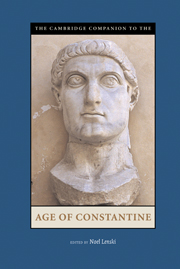Book contents
- Frontmatter
- Introduction
- 1 Sources for the History of Constantine
- Section 1 Politics and Personalities
- 2 Before Constantine
- 3 The Reign of Constantine
- 4 The Dynasty of Constantine Down to 363
- Section II Religion and Spiritual Life
- Section III Law and Society
- Section IV Art and Culture
- Section V Empire and Beyond
- Appendix 1: Stemmata
- Appendix 2: Timeline
- Maps
- Primary Sources and Translations
- Secondary Bibliography
- Index
2 - Before Constantine
from Section 1 - Politics and Personalities
Published online by Cambridge University Press: 28 September 2007
- Frontmatter
- Introduction
- 1 Sources for the History of Constantine
- Section 1 Politics and Personalities
- 2 Before Constantine
- 3 The Reign of Constantine
- 4 The Dynasty of Constantine Down to 363
- Section II Religion and Spiritual Life
- Section III Law and Society
- Section IV Art and Culture
- Section V Empire and Beyond
- Appendix 1: Stemmata
- Appendix 2: Timeline
- Maps
- Primary Sources and Translations
- Secondary Bibliography
- Index
Summary
When Apharban, envoy from the Persian king Narseh, came before the Caesar Galerius Maximianus to beg favourable terms for his defeated sovereign, his rhetoric met an angry rejoinder from the Caesar:
You observed the rule of victory towards Valerian in a fine way, you who deceived him through stratagems and took him, and did not release him until his extreme old age and dishonourable death. Then after his death, by some loathe-some art you preserved his skin and brought an immortal outrage to the mortal body.
Thus, at his moment of triumph, the Caesar referred back to one of the darkest episodes of recent imperial history. In ad 260, between Carrhae and Edessa, Narseh’s father, Shapur I, had decisively defeated a Roman army and captured the emperor Valerian (see Map 2). He recorded these deeds for posterity in both words and images at Naqsh-i Rustam and on the Kacba-i Zardušt near the ancient Achaemenid capital of Persepolis, preserving for us a vivid image of two Roman emperors, one kneeling (probably Philip the Arab, also defeated by Shapur) and the second (Valerian), uncrowned and held captive at the wrist by a gloriously mounted Persian king (Fig. 6). The equally decisive victory of Galerius over Narseh in 297 marked a dramatic reversal of fortune and can indeed stand as symbolic of how the rulers of the first Tetrarchy and their immediate predecessors had managed to regain firm military and political control over the empire.
- Type
- Chapter
- Information
- The Cambridge Companion to the Age of Constantine , pp. 35 - 58Publisher: Cambridge University PressPrint publication year: 2005
- 5
- Cited by

